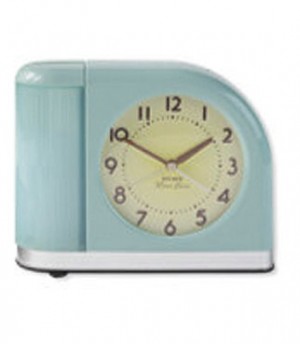How well I remember my senior year in high school. Saving up for the latest Beatles album, waiting for trigonometry to sink in and waking each morning to the sound blasting from my Big Ben alarm clock.
Who would have thought that those noise nuisances that so abruptly started the mornings of our youth would turn out to be a hot commodity in the world of collecting? eBay and Etsy and the malls of central Indiana are overflowing with them, and what is even more enticing is their presence for a few dollars at yard sales. Not certain what to look for? Here are a few tips.
Westclox has been dominated the field in the production of alarms since they released the first American mass-produced alarm clock in 1908. The Big Ben alarm, as it was called, was simply a wind up clock with a bell on the back. In 1915 the Baby Ben, a smaller clock with a key wound alarm was released. Both will be found with plain nickel-plated cases with bold numbers on the face, a style indicative of the popular Art Deco style of that era. These clocks were made to last and will often be found in working condition.
In 1931 Westclox introduced their “Big Ben Chime Alarm” with Colliers Magazine ad that read, “First he whispers, then he shouts.” This early clock, now highly sought by collectors, would awaken the sleeper starting with a series of gentle “dings” that increased in rapidity and volume for approximately one minute. The Big Ben and Baby Ben clocks would prove to be two of the most successful of the early Westclox alarms and you will find them in 10 styles in both wind up and electric clocks.
While they are considered annoying by most, no one can discount the value of a reliable alarm. During the war years of the 1940s, alarm clocks proved a reliable source for assuring that factory workers were on time for their shifts, a punctuality that was crucial to the war effort. They were, in fact, so important that while most other American factories ceased their production of consumer goods in 1942 to accommodate the needs of the U.S. military, clock companies were granted special permission from the government to resume production. From this era you will find both new clock design and reissues of prewar designs.
Ask any vintage clock enthusiast and they will tell you that you don’t really have a collection until you have a “Moonbeam” alarm from 1950. This clock has increased in popularity recently due to its retro/vintage look. Originally named the “considerate alarm,” this highly collectible piece wakes the sleeper with a graduated flashing ray of light followed after four minutes by a bell alarm. When purchasing this Westclox classic it is important to note that they have been reissued recently. The older version’s “beam” is a 25 watt light bulb, and the dial’s back light is continuously lit. While the new clocks are great to wake you, they are of no value as a collectible.
The first snooze alarm, appropriately called “The Drowse” was introduced by General Electric in 1956 and allowed the sleeper either a 5 or 10 minute snooze time. Early alarms are easily identifiable by their rocker switch. By 1969 the single button snooze was in production and became a standard feature on all models from 1982 forward. There are two 1956 models to watch for: Model #800, with a non-luminous dial in a gray case and Model #800-L, with a luminous dial in doeskin beige, pine frost green or pink.
COLLECTORS TIP: If you are looking to enter this field of collecting, one of the best deals to be had is on mid-century travel alarms. They are compact, low cost, most still operate and they are gaining in value. Until next time…Linda
Linda Kennett is a professional liquidation consultant specializing in down sizing for seniors and the liquidation of estates and may be reached at lkennett@indy.rr.com or 317-258-7835



